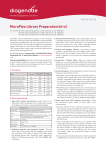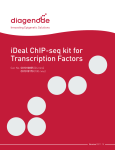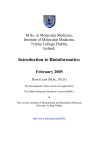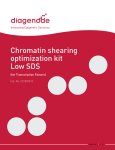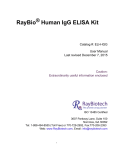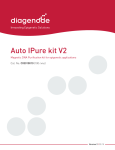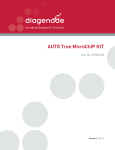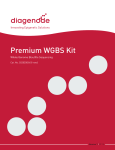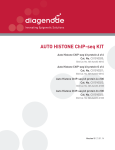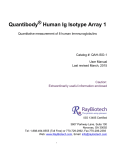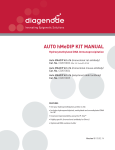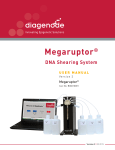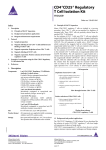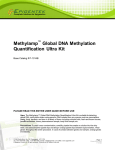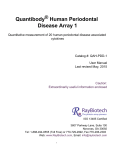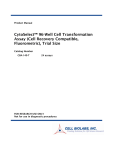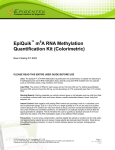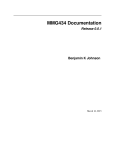Download - Diagenode
Transcript
Auto iDeal ChIP-seq kit for Transcription Factors Cat. No. C01010058 (24 rxns) Cat. No. C01010172 (100 rxns) Version 1 I 06.15 Contacts DIAGENODE HEADQUARTERS Diagenode s.a. BELGIUM | EUROPE LIEGE SCIENCE PARK Rue Bois Saint-Jean, 3 4102 Seraing - Belgium Tel: +32 4 364 20 50 Fax: +32 4 364 20 51 [email protected] [email protected] Diagenode Inc. USA | NORTH AMERICA 400 Morris Avenue, Suite #101 Denville, NJ 07834 Tel: +1 862 209-4680 Fax: +1 862 209-4681 [email protected] [email protected] For a complete listing of Diagenode’s international distributors visit: http://www.diagenode.com/company/distributors.php For rest of the world, please contact Diagenode sa. Diagenode website: www.diagenode.com PAGE 3 Content Introduction. . . . . . . . . . . . . . . . . . . . . . . . . . . . . . . . . . . . . . . . . . . . . . . . . . . . . . . . . . . . . . . . . . . . . . . . . . . . . . . . . . . . . . . . . . . . . . . . . . . . . . . . . . . . . . . . . . . . . . . . . . . . . . . . . . . . . . . . . . . . . . . . . . . . . 4 IP-Star ® and IP-Star ® Compact Systems for automation of epigenetic applications. . . . . . . . . . . . . . . . . . . . . . . . . . . . . . . . . . . . . . . . 5 Kit method overview. . . . . . . . . . . . . . . . . . . . . . . . . . . . . . . . . . . . . . . . . . . . . . . . . . . . . . . . . . . . . . . . . . . . . . . . . . . . . . . . . . . . . . . . . . . . . . . . . . . . . . . . . . . . . . . . . . . . . . . . . . . . . . . . . . . . . . . . 7 Kit materials. . . . . . . . . . . . . . . . . . . . . . . . . . . . . . . . . . . . . . . . . . . . . . . . . . . . . . . . . . . . . . . . . . . . . . . . . . . . . . . . . . . . . . . . . . . . . . . . . . . . . . . . . . . . . . . . . . . . . . . . . . . . . . . . . . . . . . . . . . . . . . . . . . . . 8 Required materials not provided. . . . . . . . . . . . . . . . . . . . . . . . . . . . . . . . . . . . . . . . . . . . . . . . . . . . . . . . . . . . . . . . . . . . . . . . . . . . . . . . . . . . . . . . . . . . . . . . . . . . . . . . . . . . . . . . . . . . . 9 Remarks before starting . . . . . . . . . . . . . . . . . . . . . . . . . . . . . . . . . . . . . . . . . . . . . . . . . . . . . . . . . . . . . . . . . . . . . . . . . . . . . . . . . . . . . . . . . . . . . . . . . . . . . . . . . . . . . . . . . . . . . . . . . . . . . . . 10 How to perform automated ChIP on the IP-Star ® Compact. . . . . . . . . . . . . . . . . . . . . . . . . . . . . . . . . . . . . . . . . . . . . . . . . . . . . . . . . . . . . . . . . . . . . . . . . . . . 12 STEP 1: Cell collection and DNA-protein cross linking. . . . . . . . . . . . . . . . . . . . . . . . . . . . . . . . . . . . . . . . . . . . . . . . . . . . . . . . . . . . . . . . . . . . . . . . . . . . . . 13 STEP 2: Cell lysis, and chromatin shearing . . . . . . . . . . . . . . . . . . . . . . . . . . . . . . . . . . . . . . . . . . . . . . . . . . . . . . . . . . . . . . . . . . . . . . . . . . . . . . . . . . . . . . . . . . . . . . . 13 STEP 3: Magnetic immunoprecipitation . . . . . . . . . . . . . . . . . . . . . . . . . . . . . . . . . . . . . . . . . . . . . . . . . . . . . . . . . . . . . . . . . . . . . . . . . . . . . . . . . . . . . . . . . . . . . . . . . . . . 14 STEP 4: Elution, decross-linking and DNA isolation . . . . . . . . . . . . . . . . . . . . . . . . . . . . . . . . . . . . . . . . . . . . . . . . . . . . . . . . . . . . . . . . . . . . . . . . . . . . . . . . . . 19 STEP 5: Quantitative PCR analysis . . . . . . . . . . . . . . . . . . . . . . . . . . . . . . . . . . . . . . . . . . . . . . . . . . . . . . . . . . . . . . . . . . . . . . . . . . . . . . . . . . . . . . . . . . . . . . . . . . . . . . . . . . . 27 How to perform automated ChIP on the IP-Star ®. . . . . . . . . . . . . . . . . . . . . . . . . . . . . . . . . . . . . . . . . . . . . . . . . . . . . . . . . . . . . . . . . . . . . . . . . . . . . . . . . . . . . . . . . . . 20 STEP 1: Cell collection and DNA-protein cross linking. . . . . . . . . . . . . . . . . . . . . . . . . . . . . . . . . . . . . . . . . . . . . . . . . . . . . . . . . . . . . . . . . . . . . . . . . . . . . . 21 STEP 2: Cell lysis, and chromatin shearing . . . . . . . . . . . . . . . . . . . . . . . . . . . . . . . . . . . . . . . . . . . . . . . . . . . . . . . . . . . . . . . . . . . . . . . . . . . . . . . . . . . . . . . . . . . . . . . 21 STEP 3: Magnetic immunoprecipitation . . . . . . . . . . . . . . . . . . . . . . . . . . . . . . . . . . . . . . . . . . . . . . . . . . . . . . . . . . . . . . . . . . . . . . . . . . . . . . . . . . . . . . . . . . . . . . . . . . . . 22 STEP 4: Elution, decross-linking and DNA isolation . . . . . . . . . . . . . . . . . . . . . . . . . . . . . . . . . . . . . . . . . . . . . . . . . . . . . . . . . . . . . . . . . . . . . . . . . . . . . . . . . . 26 STEP 5: Quantitative PCR analysis . . . . . . . . . . . . . . . . . . . . . . . . . . . . . . . . . . . . . . . . . . . . . . . . . . . . . . . . . . . . . . . . . . . . . . . . . . . . . . . . . . . . . . . . . . . . . . . . . . . . . . . . . . . 27 ChIP-sequencing . . . . . . . . . . . . . . . . . . . . . . . . . . . . . . . . . . . . . . . . . . . . . . . . . . . . . . . . . . . . . . . . . . . . . . . . . . . . . . . . . . . . . . . . . . . . . . . . . . . . . . . . . . . . . . . . . . . . . . . . . . . . . . . . . . . . . . . . . . 27 ChIP-seq data analysis recommendations . . . . . . . . . . . . . . . . . . . . . . . . . . . . . . . . . . . . . . . . . . . . . . . . . . . . . . . . . . . . . . . . . . . . . . . . . . . . . . . . . . . . . . . . . . . . . . . . . . . . 27 Additional protocols . . . . . . . . . . . . . . . . . . . . . . . . . . . . . . . . . . . . . . . . . . . . . . . . . . . . . . . . . . . . . . . . . . . . . . . . . . . . . . . . . . . . . . . . . . . . . . . . . . . . . . . . . . . . . . . . . . . . . . . . . . . . . . . . . . . . . . 30 Troubleshooting guide. . . . . . . . . . . . . . . . . . . . . . . . . . . . . . . . . . . . . . . . . . . . . . . . . . . . . . . . . . . . . . . . . . . . . . . . . . . . . . . . . . . . . . . . . . . . . . . . . . . . . . . . . . . . . . . . . . . . . . . . . . . . . . . . . . . 32 www.diagenode.com | PAGE 4 DIAGENODE AUTO IDEAL CHIP SEQ KIT FOR TRANSCRIPTION FACTORS USER MANUAL Introduction The Diagenode IP-Star® Automated System automates immunoprecipitation and increases reproducibility Diagenode, the leading provider of complete solutions for epigenetics research, offers a variety of end-to-end systems to streamline DNA methylation and chromatin immunoprecipitation workflows. Central to this full offering is Diagenode’s Automated Systems, simple yet robust automated bench-top instruments that standardize different epigenetic applications (i.e. ChIP, MeDIP or MethylCap). Diagenode designed these automation systems to make ChIP and DNA methylation studies accessible and reproducible, and ensure consistent data in every experiment. Diagenode Automated Systems will produce consistent results from any operator regardless of the day, the experimental run, or the lab. Robust and reproducible results is a major goal of today’s high resolution epigenomic studies. Diagenode Automated Platforms replace the numerous manual, error-prone steps of complex epigenetic applications with a reliable, highly consistent and automated process that requires minimal operator intervention. We empower researchers to simplify the tedious protocols and the complexity of many epigenetic protocols. In addition, Diagenode Automated Systems minimize sample carryover, data variability, and costly errors. The platforms offer full workflow support for epigenetics research, utilizing our complete kits and laboratory-validated protocols to rapidly deliver highquality and consistent data. Auto iDeal ChIP-seq kit for Transcription Factors The Auto iDeal ChIP-seq kit for Transcription Factors was developed to enhance the utility of the ChIP procedure, allowing one to perform many more ChIPs per day and per week. The entire procedure can be performed in a single day, since two overnight incubations have been eliminated. The IP has been optimized to specifically select and precipitate the chromatin with the use of our validated antibodies, buffers and protocols. Furthermore, the use of our automated system will drastically increase the consistency of your ChIP assay. The Auto iDeal ChIP-seq kit for Transcription Factors allows quick and highly specific chromatin IP sample analysis. The Auto ChIP kit protocol has been improved to allow researchers to work with smaller volumes than other traditionally used methods. The kit ensures the use of small amounts of reagents per reaction (including antibodies and buffers) and also provides you with fewer buffers in comparison with other kits. The Auto iDeal ChIP-seq kit for Transcription Factors has been validated to perform ChIP-seq experiments using antibodies directed against Transcription Factors proteins. The combination of this high quality kit and the IP-Star® allows Chromatin IP to be performed in less than 10 hours. Starting with sheared chromatin, the Automated System provides purified immunoprecipitated DNA from your sample. The Auto iDeal ChIP-seq kit for Transcription Factors protocol has been validated using chromatin sheared by sonication using the Bioruptor. Customer Feedback Not only does the IP-Star® eliminate the problem of human variation associated with producing our samples, it also enables us to produce 1000-2000 ChIP-seq samples per year very reliably. The IP-Star® reduces our processing time down from one day of manual work to just one overnight run with only 30 minutes of hands-on work. The IP-Star® has made all our ChIPs consistent and the process completely reliable regardless of the operator or the time of day. Dr. John Lambourne, Postdoctorate Researcher at the Innovation Centre, McGill University, Canada Innovating Epigenetic Solutions PAGE 5 IP-Star® and IP-Star® Compact Systems for automation of epigenetic applications Diagenode has developed two automated platforms (IP-Star® and IP-Star® Compact) designed to increase your lab’s productivity, efficiency and experimental reproducibility. The two automated platforms are capable of processing up to 16 samples per cycle. The automated systems processes sheared chromatin (or DNA) to deliver purified DNA ready for qPCR, amplification, microarray and sequencing analysis. Both, the IP-Star® and IP-star® Compact have an easy-to-use open software that provides you with flexibility. This allows you to create your personal protocol according to your specific needs. Major benefits of Diagenode Automated Platforms IP-Star® Compact IP-Star® > High resolution ChIP-seq and MeDIP-seq profiles > Automated library preparation for Next Generation sequencing > Reduces hands on time to just 30 minutes > Reduces variability between operators and labs > Ideal for low sample starting amounts > Compatible with Diagenode Kits > Reduces cross-contamination www.diagenode.com | PAGE 6 DIAGENODE AUTO IDEAL CHIP SEQ KIT FOR TRANSCRIPTION FACTORS USER MANUAL Improved reproducibility Our IP-Star® will increase the immunoprecipitation reproducibility between IPs performed by the same as well as by different operators (see figure 1 and 2 below). Reagents (Antibodies, buffers,...) and sheared chromatin were identical for “ManChIP” and “AutoChIP”. The IP-Star® Automated system removes variation that can be created by manual handling and allows you to optimize and standardize your assay within a lab. The IP-Star® is designed to improve the accuracy and the reproducibility of any immunoprecipitiation experiment. Man ChIP SD(IgG)=0,69% SD(H3K9me3)=23,84% SD(IgG)=1,4% SD(H3K9me3)=2,38% C % of input 100,0 80,0 SD(IgG)=0,94% SD(H3K9me3)=11,36% A SD(IgG)=0,17% SD(H3K9me3)=1,12% B ChIP 1 ChIP 1 ChIP 2 57,83 56,25 ChIP 2 60,0 50,70 ChIP 1 ChIP 2 98,62 95,26 SD(IgG)=0,09% SD(H3K9me3)=0,65% D ChIP 1 ChIP 2 43,83 44,75 34,63 40,0 Figure 1. Manual ChIP Four different operators have each performed two ChIP experiments using H3K9me3 antibody on the genomic region SAT2 (positive locus). 10,000 Hela cells have been used per IP. Reagents and sheared chromatin were identical per assay. The standard deviations between the ChIPs performed by the same operator and between the four different operators are displayed. 20,0 1,96 0,63 1,86 1,62 2,06 1,42 Auto ChIP 1,54 1,42 SD(IgG)=0,28% SD(H3K9me3)=1,6% 100,0 90,0 % of input 80,0 70,0 ChIP 1 ChIP 2 ChIP 3 ChIP 4 60,0 56,25 54,71 57,83 54,34 50,0 40,0 30,0 20,0 10,0 1,26 IgG H3K9me3 Innovating Epigenetic Solutions 1,00 1,45 IgG H3K9me3 IgG 0,81 H3K9me3 IgG H3K9me3 Figure 2. Automated ChIP Four ChIP experiments using H3K9me3 antibody on the genomic region SAT2 (positive locus) have been performed by the IP-Star®. 10,000 Hela cells have been used per IP. Reagents and sheared chromatin were identical per assay. The standard deviations between the four ChIPs performed by the IP-Star® are displayed. PAGE 7 Kit method overview Figure 3. Diagenode provides a full suite of automated solutions for ChIP experiments For Step 1, we offer products to isolate nuclei and chromatin. Step 2 describes reproducible sample shearing with the Bioruptor® product line. In Step 3 and Step 4, the Diagenode IP-Star Compact provides error-free, walk-away automation for all your immunoprecipitation and antibody capture needs. www.diagenode.com | PAGE 8 DIAGENODE AUTO IDEAL CHIP SEQ KIT FOR TRANSCRIPTION FACTORS USER MANUAL Kit materials The Auto iDeal ChIP-seq kit for Transcription Factors x100 contains reagents to perform 17 different chromatin preparations, 100 Chromatin Immunoprecipitations and DNA Purification by using the IP-Star's Automated System. The Auto iDeal ChIP-seq kit for Transcription Factors x24 contains reagents to perform 4 different chromatin preparations, 24 Chromatin Immunoprecipitations and DNA Purification by using the IP-Star's Automated System. The kit content is described in Table 1. Upon receipt, store the components at the temperatures indicated in Table 1. Table 1. Kit content Description Quantity (x24) Quantity (x100) Storage Protease inhibitor cocktail 92 µl 385 µl -20°C 5% BSA (DNA free) 550 µl 3.5 ml -20°C 15 µg (1 µg/µl) 40 µg (1 µg/µl) -20°C 10 µg (2.5 µg/µl) 40 µg (2.5 µg/µl) -20°C ChIP-seq grade H19 imprinting control region primer pair 50 µl 500 µl -20°C ChIP-seq grade Myoglobin exon 2 primer pair 50 µl 500 µl -20°C Carrier 67 µl 320 µl -20°C Glycine 9,7 ml 40 ml 4°C Shearing Buffer iS1b 7,5 ml 31 ml 4°C DiaMag protein A-coated magnetic beads 800 µl 3.3 ml 4°C - DO NOT FREEZE Wash buffer iW1 10 ml 42 ml 4°C Wash buffer iW2 10 ml 42 ml 4°C Wash buffer iW3 10 ml 42 ml 4°C Wash buffer iW4 10 ml 42 ml 4°C ChIP-seq grade water 15 ml 120 ml 4°C Elution Buffer iE2 540 µl 720 µl 4°C Fixation buffer 6,1 ml 26 ml 4°C Wash buffer 1 w/o iso-propanol 2 ml 8 ml 4°C Wash buffer 2 w/o iso-propanol 2 ml 8 ml 4°C Buffer C 1,7 ml 8 ml 4°C IPure Beads v2 260 µl 1.6 ml 4°C - DO NOT FREEZE Elution Buffer iE1 12 ml 16 ml 4°C 5x ChIP Buffer iC1b 4,4 ml 32 ml 4°C Lysis Buffer iL1b 110 ml 470 ml 4°C Lysis Buffer iL2 66 ml 280 ml 4°C Rabbit IgG ChIP-seq grade CTCF antibody Table 2. Kits and Modules available separately Description Reference Quantity ChIP Cross-ling Gold C01019027 600 µl Chromatin Shearing Optimization Kit - Low SDS (for TFs) C01020013 25 rxns Auto IPure kit v2 x100 C03010010 100 rnx Innovating Epigenetic Solutions PAGE 9 Table 3. Plastics and consumables available separately Description Reference Quantity C30020001 80 200 μl tube strips (8 tubes/strip) + cap strips for SX-8G IP-Star Compact C30020002 120 96 well microplates for IP-Star® C30080030 10 Tips (box) C30040021 960 C30040020 1000 2 ml microtube for SX-8G IP-Star Compact C30010014 100 Large reagent container for SX-8G IP-Star® Compact C30020004 20 Medium reagent container for SX-8G IP-Star® Compact C30020003 10 200 μl tube strips (12 tubes/strip) + cap strips ® Tips (bulk) ® Required materials not provided Reagents • Gloves to wear at all steps • Formaldehyde, 37%, Molecular Grade • Phosphate buffered saline (PBS) buffer • 1 M Sodium butyrate (NaBu) (Cat. No. C12020010) (optional) • 100% isopropanol • RNase/DNase-free 1.5 ml tubes • qPCR SYBR® Green Mastermix •Reagents for library preparation, cluster generation (Illumina®) or ePCR (Ion TorrentTM PGMTM) and sequencing • Quant-IT dsDNA HS assay kit (Invitrogen) • Diagenode ChIP cross-link Gold (Cat N° C01019027) (Optional) For library preparation, we highly recommend • High Resolution Library Preparation kit (Cat. No. C05010023) • MicroPlex Library PreparationTM kit v2 (Cat. No. C05010012, 12 reactions, 12 indices) (Cat. No. C05010013, 48 reactions, 12 indices) Equipment • Diagenode DiaMag02 magnetic rack (Cat. No. B04000001) • Diagenode Bioruptor® sonication device (Cat. No. Standard: B01010001, Plus: B01020001, and Pico: B01060001) • Diagenode 1.5 ml TPX Microtubes (optimized for chromatin shearing with Bioruptor® Standard or Plus) (Cat.No. C30010010) or 1.5 ml Bioruptor® Microtubes with Caps (Cat No C30010016) optimized for chromatin shearing with Bioruptor® Pico • Refrigerated centrifuge for 1.5 ml, 15 ml and 50 ml tubes • Cell counter • Vortex • Thermomixer • Qubit system (Invitrogen) • qPCR cycler • For tissues: Petri dishes www.diagenode.com | PAGE 10 DIAGENODE AUTO IDEAL CHIP SEQ KIT FOR TRANSCRIPTION FACTORS USER MANUAL Remarks before starting 1. Cell number (for cultured cells) This protocol has been optimized for ChIP on 4,000,000 cells in 200 μl ChIP reaction. For using lower amounts of cells, simply dilute the chromation in shearing buffer before adding it to the IP reaction. For higher cell numbers you can increase the cell concentration in the shearing buffer, although this may require an additional optimization of the shearing conditions. Therefore, we recommend performing separate ChIP's and pool the IP'd DNA before purification. 2. Cell fixation Formaldehyde is the most commonly used cross-linking reagent. However, formaldehyde is usually not effective to cross-link proteins that are not directly bound to the DNA. For example, chromatin interactions with inducible transcription factors or with cofactors that interact with DNA through protein-protein interactions are not well preserve with formaldehyde. When studying this kind of factors, we recommend the use of the Diagenode ChIP cross-link Gold (Cat N° C01019027). This reagent is to use in combination with formaldehyde. The protocol involves a sequential fixation. A first protein-protein fixation by the ChIP cross-link Gold followed by protein-DNA fixation by formaldehyde. 3. Shearing optimization and sheared chromatin analysis Before starting the ChIP, the chromatin should be sheared into fragments of 100 to 600 bp. Our kits and protocols are optimized for chromatin shearing using the Bioruptor® (Standard, Plus and Pico). The maximum volume for shearing with the Bioruptor® is 300 μl per 1.5 ml Microtube (depending on the specific type). We recommend using TPX tubes (C30010010) for Bioruptor® Standard and Plus as shearing has been shown to be more efficient and reproducible using these tubes. For Bioruptor® Pico we recommend using 1.5 ml Microtubes with Caps (C30010016). The shearing conditions mentioned in the protocol are adequate for a variety of cell types. However, given that cell types are different, we recommend optimizing sonication conditions for each cell type before processing large quantities of cells or samples. It is important to perform an initial sonication time course experiment to evaluate the extent of chromatin fragmentation. A protocol to assess the shearing efficiency can be found in the “Additional Protocols” section. 4. Magnetic beads This kit includes DiaMag Protein A-coated magnetic beads. Make sure the beads do not dry during the procedure as this will result in reduced performance. Keep the beads homogenously in suspension at all times when pipetting. Variation in the amount of beads will lead to lower reproducibility. Do not freeze the beads. The amount of beads needed per IP depends on the amount of antibody used for the IP. The protocol below uses 10-20 μl of beads. The binding capacity of this amount is approximately 2.5-5 μg of antibody. With most of Diagenode’s high quality ChIP-seq grade antibodies the recommended amount to use is 1 to 2 μg per IP reaction. Therefore, you can reduce the amount of beads accordingly. 5. Negative and positive IP controls (IgG and control Ab) The kit contains a negative (IgG) and a positive (CTCF) control antibody. We recommend including one IgG negative IP control in each series of ChIP reactions. We also recommend using the positive control ChIP-seq grade CTCF antibody at least once. The kit also contains qPCR primer pairs for amplification of a positive and negative control target for CTCF (H19 imprinting control region and Myoglobin exon 2, respectively). 6. Quantification Determine the concentration of the IP’d DNA after the ChIP with a highly sensitive method such as the 'Quant-IT dsDNA HS assay kit’ on the Qubit system from Invitrogen. PicoGreen is also suitable but UV spectrophotometric methods such as the NanoDrop are usually not sufficiently sensitive. In most cases it is sufficient to use approximately 10% of the IP'd material for quantification. The expected DNA yield will be dependent on different factors such as the cell type, the quality of the antibody used and the antibody target. The expected DNA yield obtained with the positive control CTCF antibody on Innovating Epigenetic Solutions 4,000,000 HeLa cells is approximately 20 ng. 7. Quantitative PCR Before sequencing the samples, we recommend analysing the IP’d DNA by qPCR using at least 1 positive and 1 negative control target. The kit contains a positive and negative control primer pair which can be used for the CTCF positive control antibody in SYBR® Green qPCR assay using the protocol described in the manual. Use your own method of choice for analysing the appropriate control targets for your antibodies of interest. In order to have sufficient DNA left for sequencing, we recommend not using more than 10% of the total IP’d DNA for qPCR. You can dilute the DNA (1/10 or more) to perform sufficient PCR reactions. PCR reactions should be performed at least in duplicate although performing them in triplicate is recommended to be able to identify potential outliers. 8. Quantitative PCR data interpretation The efficiency of chromatin immunoprecipitation of particular genomic loci can be expressed as the recovery of that locus calculated as the percentage of the input (the relative amount of immunoprecipitated DNA compared to input DNA). If the amount used for the input was 1% of the amount used for ChIP, the recovery can be calculated as follows: % recovery = 2^(Ctinput – Ctsample) Ctsample and Ctinput are the threshold cycles from the exponential phase of the qPCR for the IP’d DNA sample and input, respectively. This equation assumes that the PCR is 100% efficient (amplification efficiency = 2). For accurate results the real amplification efficiency, if known, should be used. For the positive control antibody (CTCF) the recovery of the positive control target (H19 imprinting control region) is expected to be approximately 5% although this will depend on the cell type used. The recovery of the negative control target (Myoglobin exon 2 locus) should be below 0.5%. 6 H19 imprinting control region Myoglobin exon 2 5 % of input 4 3 2 1 0 CTCF IgG Figure 4: ChIP was performed on human HeLa cells using the control antibodies from the iDeal ChIP-seq kit for Transcription Factors. Sheared chromatin from 4 million cells, 0.5 μl of the positive control antibody and 1 μl of the negative IgG control were used per IP. Quantitative PCR was performed with the positive control H19 imprinting control region and the negative control Myoglobin exon 2 primer sets from the kit. The recovery, expressed as a % of input (the relative amount of immunoprecipitated DNA compared to input DNA after qPCR analysis). ® IP-STAR COMPACT PAGE 12 How to perform Automated ChIP on the IP-Star® Compact PAGE 13 Protocol STEP 1. C ell collection and DNA-protein cross-linking 1. Dilute formaldehyde in Fixation buffer to a final concentration of 11%, e.g. add 5 ml of a 37% formaldehyde solution to 11.8 ml Fixation buffer. For a T175 culture flask you will need ~2 ml of diluted formaldehyde. NOTE: When studying inducible transcription factors or cofactors, it is recommended to perform the fixation using the ChIP cross-link Gold (C01019027) in addition to the formaldehyde fixation 2. Add 1/10 volume of the diluted formaldehyde directly to the cell culture medium. 3. Incubate the cells for 10 to 20 minutes at room temperature with gentle shaking. The fixation time can depend on your target of interest. 4. dd 1/10 volume of Glycine to the cell culture medium to stop the fixation. Incubate for 5 minutes at room temperature A with gentle shaking. NOTE: The fixed cells can be stored at -80°C for up to 4 months. However, we strongly recommend using freshly fixed cells for preparation of sheared chromatin prior to ChIP for ChIP-sequencing. STEP 2. C ell lysis and chromatin shearing For adherent cells: 5a.Remove the medium and wash the cells once with 20 ml of PBS. Keep everything at 4°C from now on. 6a.Add 5 ml of cold Lysis buffer iL1b to the plate and collect the cells by scraping. 7a.Add an additional volume of Lysis buffer iL1b to rinse the flask and add this to the collected cells. The total volume of Lysis buffer iL1b should be about 10 ml per 107 cells (e.g. for a T175 culture flask (~25 milllion cells), rinse with an additional 20 ml of buffer iL1b. 8a.Incubate at 4°C for 20 minutes. For suspension cells: 5b.Pellet the cells by centrifugation at 1,600 rpm and 4°C for 5 minutes. Discard the cell culture medium. 6b.Wash the cells once with PBS. Resuspend the cells in 20 ml of PBS, centrifuge at 1,600 rpm and 4°C for 5 minutes and discard the supernatant. Keep everything at 4°C from now on. 7b.Add 1 ml ice-cold lysis buffer iL1b to the cell pellet and resuspend the cells by pipetting up and down several times. Add an additional amount of buffer iL1b to obtain a total volume of about 10 ml per 107 cells (e.g. for a T175 culture flask (~25 milllion cells), add an additional 24 ml of buffer iL1b. 8b.Incubate at 4°C for 20 minutes. 9. Pellet the cells by centrifugation at 1,600 rpm for 5 minutes and 4°C and discard the supernatant. 10.Add 1 ml ice-cold Lysis buffer iL2 to the cell pellet and resuspend the cells by pipetting up and down several times. Add an additional amount of buffer iL2 and incubate for 10 minutes at 4°C with gentle mixing. For 25 million cells the total amount of iL2 should be 15 ml. 11. Pellet the cells again by centrifugation for 5 minutes at 1,600 rpm (500 x g) and 4°C and discard supernatant. 12.Add 200x protease inhibitor cocktail to Shearing buffer iS1b. Prepare 1 ml of complete shearing buffer per tube of 15 million cells. Keep on ice 13.Add 1 ml of complete Shearing buffer iS1b to 20 Million cells. Resuspend the cells by pipetting up and down several times. The final cell concentration should be 2 Million cells per 100 µl buffer iS1b. Split into aliquots of 100 to 300 µl and transfer the cell suspension to 1.5 ml TPX microtubes (Diagenode cat. No. M-50001) when using the Bioruptor Standard or Plus or to 1.5 ml Bioruptor® Microtubes with Caps (Cat No C30010016) optimized for chromatin shearing with the Bioruptor® Pico. 14.Shear the chromatin by sonication using the Bioruptor®. When using the Bioruptor Standard or Plus, shear for 1 to 3 runs of 10 cycles [30 seconds “ON”, 30 seconds “OFF”] each at high power setting. Briefly vortex and spin between www.diagenode.com | PAGE 14 DIAGENODE AUTO IDEAL CHIP SEQ KIT FOR TRANSCRIPTION FACTORS USER MANUAL each run. Shear for 8-10 cycles [30 seconds “ON”, 30 seconds “OFF”] when using the Bioruptor Pico. These shearing conditions will work excellent for many cell types. However, depending on the cell type and Bioruptor® system used, optimisation may be required. 15. Centrifuge at 13,000 rpm (16,000 x g) for 10 minutes and collect the supernatant which contains the sheared chromatin. Use the chromatin immediately in immunoprecipitation or store it at -80°C for up to 2 months. If desired, the chromatin shearing effciciency can be analysed at this step (see the protocol in Additional protocols.) STEP 3. M agnetic immunoprecipitation This protocol has been optimised for ~4 Million cells per ChIP, although it is possible to reduce or increase the amount of cells. For using lower amounts of cells, simply dilute the chromation in shearing buffer before adding it to the IP reaction. For higher cell numbers you can increase the cell concentration in the shearing buffer, although this may require an additional optimization of the shearing conditions. Therefore we recommend performing separate ChIP's and pool the samples before purification of the DNA. ChIP method With this method the antibody is first coated on the surface of the magnetic beads and after that the bound antibodies are added to the sheared chromatin. 16.Switch ON the IP-Star® Compact. 17.Select “Protocols” icon and then “ChIP” category. 18.Select “Direct method” and then “ChIP_IPure_200_D” protocol in the list. NOTE: If you plan to run between 1 and 8 samples, chose “ChIP_IPure_8_200_D” If you plan to run between 9 and 16 samples, chose “ChIP_IPure_16_200_D” Innovating Epigenetic Solutions PAGE 15 19.Setup the exact number of samples for your experiment. Each IP has to be counted as a sample. Input is not a sample. NOTE: The Peltier Block is now cooling down to 4°C to keep your samples cold 20.Setup the parameters for your ChIP experiment and press “Next” Setup the “Ab coating” step to 3 hours Setup the “IP reaction” step to 10-15 hours (overnight) Setup the “Washes” step to 5-10 min 21.Setup all the plastics on the platform according to the screen layout. TIP Rack TIP Rack Reagent Rack 1 Reagent Rack 2 Left Peltier Block Right Peltier Block 96 plate 1 96 plate 2 22.Fill TIP Rack 1 (and 2 if processing 16 samples protocol) with tips according to the screen. 23.Fill Reagent Racks 1 & 2 with reagent containers according to the screen. 24.Fill Peltier block with your sample, antibody and magnetic beads as mentioned her below www.diagenode.com | PAGE 16 DIAGENODE AUTO IDEAL CHIP SEQ KIT FOR TRANSCRIPTION FACTORS USER MANUAL Direct ChIP 1. Prepare 1x ChIP Buffer iC1b + BSA 5% (1/50) Mix for 1 IP (300µl per IP is needed) 5x ChIP Buffer iC1b 60 µl ChIP-seq grade Water 234 µl 5% BSA (DNA free) 6 µl • I f � 8 samples, prepare 300 µl excess (1 IP excess) • If � 9 samples, prepare 1200 µl excess (4 IP excess) 2. Preparation of Ab coating mix (Well 6) Antibody x µl 1x ChIP Buffer iC1b + BSA 5% (1/50) 100 – x µl 200x Protease Inhibitor Cocktail 0.5 µl Use 1 μl (1µg/µl) of the IgG negative control antibody for the negative control IP. If a positive control IP is included in the experiment, use 0.5 μl (2.5µg/µl) of the CTCF positive control antibody 3. Preparation Immunoprecipitation mix (Well 7) Sheared chromatin 200 µl BSA 5% 4 µl 200x Protease Inhibitor Cocktail 1 µl Keep 2 µl of the sheared chromatin aside for the Input This Auto iDeal ChIP-seq kit for Transcription Factors has been optimized with Diagenode’s high quality ChIP-grade antibodies and we use very low amounts of antibody per IP. The binding capacity of 10 µl of magnetic beads is ~3 µg of antibody. If you plan to use more than 3 µg of antibody per IP we recommend that the quantity of beads is adjusted accordingly. Please contact us for advice. NOTE: If required, NaBu (HDAC inhibitior, 20mM final concentration) or other inhibitors can also be added to the chromatin sample. 25.Fill Reagent Racks 1 & 2 with reagent according to the screen instructions and Press “Next” Beads Wash Buffer: 1x ChIP buffer iC1b + BSA 5% (1/50) Elution buffer: Elution Buffer iE1 IP wash 1: Wash Buffer iW1 IP wash 2: Wash Buffer iW2 IP wash 3: Wash Buffer iW3 IP wash 4: Wash Buffer iW4 Innovating Epigenetic Solutions PAGE 17 26.Check the selected parameters, close the door and press “Run” to start 27.C hIP is running. The “Remaining time” calculation will give you an estimation of the processing time of your experiment. Protocol name Progress bar Current temperature value 28.The next morning, after the overnight incubation. Recover the sample tubes and place them on the DiaMag02 magnetic rack (Cat. No. B04000001). Keep the supernatant and discard the beads. •Setup the Input in the 1st well INPUT= 2 µl sheared chromatin + 94 µl Elution Buffer iE1 •Add 4 µl of Elution Buffer iE2 (5M NaCl) in all the samples (well 12) and inputs (well 1) • Close the tubes with the caps, close the door and press OK NOTE 1: (optionnal) Proteinase K can be added for the reverse crosslinking. However, Diagenode does not provide Proteinase K. NOTE 2: (optionnal) RNase treatment by incubating the samples with RNase at 37°C during 30 minutes can be performed after the reverse crosslinking and it is recommended for ChIP-seq experiments. However, Diagenode does not provide RNase. www.diagenode.com | PAGE 18 DIAGENODE AUTO IDEAL CHIP SEQ KIT FOR TRANSCRIPTION FACTORS USER MANUAL 29.Recover the samples in the well 12 and inputs in well 1. Press “OK” and then “YES” to start a new run. Samples are now ready for purification. Innovating Epigenetic Solutions PAGE 19 STEP 4. E lution, decross-linking and DNA isolation After the reverse-crosslinking, DNA purification is performed using our simplified and validated Auto IPure reagents included in the Auto iDeal ChIP-seq kit for Transcription Factors and the related protocol on the IP-Star®. 30.Select “Protocols” icon and then “IPure” category. 31.Select IPure protocol for an elution in 50 µl and IPure-seq protocol for an elution in 25 µl. NOTE: If you plan to run between 1 and 8 samples, chose “IPure_08 or IPure-seq_08” If you plan to run between 9 and 16 samples, chose “IPure_16 or IPure-seq_16” If you plan to run between 17 and 24 samples, chose “IPure_24 or IPure-seq_24” 32.Setup the exact number of samples for your experiment. Each IP and input has to be counted as a sample. NOTE: The Peltier Block is now cooling down to 4°C to keep your samples cold. 33.Setup all the plastics on the platform according to the screen layout. 34.Add 2 μl of carrier to each IP and input sample and place them on the Left block. 35.Resuspend and dispense 10 µl of magnetic beads (IPure) for each sample on the 96 well plate NOTE: Keep the magnetic beads in liquid suspension during storage at 4°C and at all handling steps, as drying will result in reduced performance. Make sure the beads are homogeneously in suspension at all the time during pipetting steps because the beads are precipitating rapidly. 36.Dilute Wash Buffers 1:1 with isopropanol Wash buffer 1 Wash buffer 2 24 rxns 100 rxns 24 rxns 100 rxns Wash buffer 1w/o isopropanol 2 ml 8 ml Wash buffer 1w/o isopropanol 2 ml 8 ml Isopropanol (100%) 2 ml 8 ml Isopropanol (100%) 2 ml 8 ml Total volume 4 ml 16 ml Total volume 4 ml 16 ml 37.Dispense Wash Buffers 1 & 2 with Isopropanol in the appropriate container in the IP-Star® 38.Dispense Buffer C in the appropriate container in the IP-Star® 39.Press Run to start 40.At the end of the run, recover your samples on the left block at 4°C 41.Press OK, remove the consumables and switch off the IP-Star® www.diagenode.com | IP-STAR ® How to perform Automated ChIP on the IP-Star® PAGE 21 42.Place the DNA on ice and proceed to any desired downstream applications, or store it at -20°C or -80°C until further use. STEP 1. C ell collection and DNA-protein cross-linking Protocol 1.Dilute formaldehyde in Fixation buffer to a final concentration of 11%, e.g. add 5 ml of a 37% formaldehyde solution to 11.8 ml Fixation buffer. For a T175 culture flask you will need ~2 ml of diluted formaldehyde. NOTE: When studying inducible transcription factors or cofactors, it is recommended to perform the fixation using the ChIP cross-link Gold in addition to the formaldehyde fixation 2. Add 1/10 volume of the diluted formaldehyde directly to the cell culture medium. 3.Incubate the cells for 10 to 20 minutes at room temperature with gentle shaking. The fixation time can depend on your target of interest. 4.Add 1/10 volume of Glycine to the cell culture medium to stop the fixation. Incubate for 5 minutes at room temperature STEP 2a. C ell lysis and chromatin shearing with gentle shaking. NOTE: The fixed cells can be stored at -80°C for up to 4 months. However, we strongly recommend using freshly fixed cells for preparation of sheared chromatin prior to ChIP for ChIP-sequencing. For adherent cells: 5a. Remove the medium and wash the cells once with 20 ml of PBS. Keep everything at 4°C from now on. 6a.Add 5 ml of cold Lysis buffer iL1b to the plate and collect the cells by scraping. 7a.Add an additional volume of Lysis buffer iL1b to rinse the flask and add this to the collected cells. The total volume of Lysis buffer iL1b should be about 10 ml per 107 cells (e.g. for a T175 culture flask (~25 milllion cells), rinse with an additional 20 ml of buffer iL1b. 8a.Incubate at 4°C for 20 minutes. For suspension cells: 5b.Pellet the cells by centrifugation at 1,600 rpm and 4°C for 5 minutes. Discard the cell culture medium. 6b.Wash the cells once with PBS. Resuspend the cells in 20 ml of PBS, centrifuge at 1,600 rpm and 4°C for 5 minutes and discard the supernatant. Keep everything at 4°C from now on. 7b.Add 1 ml ice-cold lysis buffer iL1b to the cell pellet and resuspend the cells by pipetting up and down several times. Add an additional amount of buffer iL1b to obtain a total volume of about 10 ml per 107 cells (e.g. for a T175 culture flask (~25 milllion cells), add an additional 24 ml of buffer iL1b. 8b.Incubate at 4°C for 20 minutes. 9. Pellet the cells by centrifugation at 1,600 rpm for 5 minutes and 4°C and discard the supernatant. 10. Add 1 ml ice-cold Lysis buffer iL2 to the cell pellet and resuspend the cells by pipetting up and down several times Add an additional amount of buffer iL2 and incubate for 10 minutes at 4°C with gentle mixing. For 25 million cells the total amount of iL2 should be 15 ml. 11. Pellet the cells again by centrifugation for 5 minutes at 1,600 rpm (500 x g) and 4°C and discard supernatant. 12. Add 200x protease inhibitor cocktail to Shearing buffer iS1b. Prepare 1 ml of complete shearing buffer per tube of 15 million cells. Keep on ice 13. Add 1 ml of complete Shearing buffer iS1b to 15 Million cells. Resuspend the cells by pipetting up and down several times. The final cell concentration should be 1.5 Million cells per 100 µl buffer iS1b. Split into aliquots of 100 to 300 www.diagenode.com | PAGE 22 DIAGENODE AUTO IDEAL CHIP SEQ KIT FOR TRANSCRIPTION FACTORS USER MANUAL µl and transfer the cell suspension to 1.5 ml TPX microtubes (Diagenode cat. No. M-50001) when using the Bioruptor Standard or Plus or to 1.5 ml Bioruptor® Microtubes with Caps (Cat No C30010016) optimized for chromatin shearing with the Bioruptor® Pico. 14. Shear the chromatin by sonication using the Bioruptor®. When using the Bioruptor Standard or Plus, shear for 1 to 3 runs of 10 cycles [30 seconds “ON”, 30 seconds “OFF”] each at high power setting. Briefly vortex and spin between each run. Shear for 8-10 cycles [30 seconds “ON”, 30 seconds “OFF”] when using the Bioruptor Pico. These shearing STEP 3. M agnetic immunoprecipitation conditions will work excellent for many cell types. However, depending on the cell type and Bioruptor® system used, optimisation may be required. 15. Centrifuge at 13,000 rpm (16,000 x g) for 10 minutes and collect the supernatant which contains the sheared chromatin. Use the chromatin immediately in immunoprecipitation or store it at -80°C for up to 2 months. If desired, the chromatin shearing effciciency can be analysed at this step (see the protocol in Additional protocols.) This protocol has been optimised for ~4 Million cells per ChIP, although it is possible to reduce or increase the amount of cells. For using lower amounts of cells, simply dilute the chromation in shearing buffer before adding it to the IP reaction. For higher cell numbers you can increase the cell concentration in the shearing buffer, although this may require an additional optimization of the shearing conditions. Therefore we recommend performing separate ChIP's and pool the samples before purification of the DNA. ChIP direct method (Ab coating) With this method the antibody is first coated on the surface of the magnetic beads and after that the bound antibodies are added to the sheared chromatin. 1. P repare 1x ChIP Buffer iC1b + BSA 5% (1/50) Mix for 1 IP (300µl per IP is needed) 5x ChIP Buffer iC1b 60 µl ChIP-seq grade Water 234 µl 5% BSA (DNA free) 6 µl • I f � 8 samples, prepare 300 µl excess (1 IP excess) • If � 9 samples, prepare 1200 µl excess (4 IP excess) 2. Preparation of Ab coating mix (Well 6) Antibody x µl 1x ChIP Buffer iC1b + BSA 5% (1/50) 100 – x µl 200x Protease Inhibitor Cocktail 0.5 µl Use 1 μl (1µg/µl) of the IgG negative control antibody for the negative control IP. If a positive control IP is included in the experiment, use 0.5 μl (2.5µg/µl) of the CTCF positive control antibody 3. Preparation Immunoprecipitation mix (Well 7) Ab200 coating mix µl 4 µl Immunoprecipitation mix Sheared chromatin Elution buffer (Input) BSA 5% Bead washes 200x Protease Inhibitor Cocktail 1 µl Washes Keep 2 µl of the sheared chromatin aside for the Input 4. 1Load the 2 reagents 3 4 Innovating Epigenetic Solutions 5 6 7 8 9 10 11 Elution buffer (IP) 12 PAGE 23 IPURE Tube # Description 200 µl protocol 1 Elution Buffer iE1 + Elution Buffer iE2 94 µl + 4 µl 2 Empty 3 Magnetic beads* 4 1x ChIP Buffer iC1b + BSA 5% (1/50) 100 µl 5 1x ChIP Buffer iC1b + BSA 5% (1/50) 100 µl 6 Ab coating mix 100 µl 7 Immunprecipitation mix 200 µl 8 Wash Buffer iW1 150 µl 9 Wash Buffer iW2 150 µl 10 Wash Buffer iW3 150 µl 11 Wash Buffer iW4 150 µl 12 Elution Buffer iE1 + Elution Buffer iE2 10-20 µl 96 µl + 4 µl * This Auto iDeal ChIP-seq kit for Transcription Factors has been optimized with Diagenode’s high quality ChIP-grade antibodies and we use very low amounts of antibody per IP. The binding capacity of 10 µl of magnetic beads is ~3 µg of antibody. If you plan to use more than 3 µg of antibody per IP we recommend that the quantity of beads is adjusted accordingly. Please contact us for advice if required. NOTE: If required, NaBu (HDAC inhibitior, 20mM final concentration) or other inhibitors can also be added to the Immunoprecipitation mix. Running protocol Be sure that the computer connected to the SX-8G IP-Star never switches to the standby modus. (standby modus has to be inactivated). Standby of the computer will lead to the abort of the protocol. Table 3. Protocol Name Reagent Preparation* ChIP IPure 200 protocol 1h Magnetic Bead Washes 30 min Ab coating 3 hours IP reaction 10-15 hours Washes and elution Add reagents DNA isolation or reverse cross-linking DNA recovery 1h 15 min 4h (reverse cross-linking) ds DNA * Input required is sheared chromatin ready-to-ChIP 1. Switch on the SX-8G IP Star. The power switch is on the right side of the instrument. 2. Switch on the computer. 3. Start SX-8G V52 software through the following icon > 4. Place the prepared tube strip on the right cooling / heating block of the workstation www.diagenode.com | PAGE 24 DIAGENODE AUTO IDEAL CHIP SEQ KIT FOR TRANSCRIPTION FACTORS USER MANUAL 11 0 5. Close the workstation door and lock it using the following icon > 6. Press the following icon> Select "ChIP IPure 8 200" protocol IMPORTANT NOTE: If the ChIP protocols do not appear in the screen, 1. Open the SX-8V52 directory 2. O pen Easy start ini file. Write the directory location of the protocols The Easy start ini file should contain the following information: [EASYSTARTSCREEN] HoldFilePath = C:\Documents and Settings\Desktop\New software protocols\ChIP\Ab Coating for loading ChIP Direct protocols In red it is indicated the directory location of the ChIP protocols. Before starting the protocol a start confirmation window will appear. Press OK and the protocol will run. Innovating Epigenetic Solutions PAGE 25 Alternatively, incubation time for antibody coating and temperature and incubation time for the IP reaction can be adjusted in an existing protocol by selecting the modify button. The modified protocol can also be saved as new protocol. If running ChIP 16 protocol, setup half of the incubation time. It will incubate half of the time on each block but total time will be correct. (For instance, if you want 10h incubation, you have to setup 5h) www.diagenode.com | PAGE 26 DIAGENODE AUTO IDEAL CHIP SEQ KIT FOR TRANSCRIPTION FACTORS USER MANUAL 7. The program will run through the following steps: magnetic bead washes, IP and IP washes. During protocol the next window will be displayed indicating the step that the protocol is processing. 8. Reverse crosslinking After the IP washes the following window will be appear. 1. Add 1 % Input to well 1: 2 µl of sheared chromatin 2. Close the tube strip with the corresponding caps. 3. Press OK. 4. Reverse crosslinking will be performed at 65°C for 4 hours or O.N. NOTE: (Optional) RNase treatment by incubating the samples with RNase at 37°C during 30 minutes can be performed after the reverse crosslinking. Diagenode does not provide RNase. STEP 4. Elution, decross-linking and DNA isolation After the reverse-crosslinking, DNA purification is performed using our simplified and validated Auto IPure reagents included in the Auto iDeal ChIP-seq kit for Transcription Factors and the related protocol on the IP-Star. To run this protocol on the IP-Star, please follow the instructions from the manual Auto IPure kit v2 (C03010010). Innovating Epigenetic Solutions PAGE 27 STEP 5. Q uantitative PCR analysis Before sequencing the samples, we recommend analysis the IP'd DNA by qPCR using at least 1 positive and 1 negative control target. The kit contains a positive (H19 imprinting control region) and negative (Myoglobin Exon 2) control primer pair which can be used for the positive control antibody provided in the kit (CTCF ChIP-seq grade analysing the appropriate control targets for your antibodies of interest. 42. Prepare the qPCR mix as follow (20 µl reaction volume using the provided control primer pairs) : • 10 µl of a 2x SUBR® Green qPCR master mix • 1 µl of primer mix • 4 µl of water • 5 µl IP'd or input DNA 43. Use the following PCR program: 3 to 10 min denaturation step at 95°C (please check carefully supplier's recommendations about Taq polymerase activation time), followed by 40 cycles of 30 seconds at 95°C, 30 seconds at 60°C and 30 seconds at 72°C. These conditons may require optimization depending on the type of Master Mix or qPCR system used. ChIP-sequencing The iDeal protocol has been optimized for ChIP-seq on an Illumina® HiSeq Next-Gen sequencer. However, other sequencing systems such as the Illumina® MiSeq or the Life Technologies SOLiDTM systems can also be used. Please, do not hesitate to contact our customer support team if you have any questions about the design of your ChIP-seq experiment or the bioinformatics data analysis. ASK THE EXPERTS Contact for Europe, Asia, Oceania and Africa: [email protected] Contact for North and South America: [email protected] ChIP-seq data analysis recommendations To find the captured regions of the genome after sequencing you must perform a) a reference alignment followed by b) a peak calling, then c) further data analysis (annotation, visualization etc.) to help you find what you are looking for. There are abundant software tools for each task that use different approaches to the same problem; choose your preferred one considering your dataset and scientific goals. The workflows for different sequencers basically differ only in the alignment step, since every sequencer has its own characteristic read set (short or long, fixed or variable length, nucleotide or colour code etc.). a) The built-in aligners with default settings worked very well for our ChIP-seq experiments (e.g. ELAND for Illumina®, TMAP for PGM). If you cannot access them, open source tools are also available; we have positive experience with BWA: http://bio-bwa.sourceforge.net. If you use a multipurpose aligner, do not forget to use settings appropriate to your dataset; please consult with the manual of your software. b) The purpose of the peak calling is to find the enriched regions in the alignment. Take extreme care when you choose and set up your peak caller, since the outcome can vary widely depending on the used software and its settings. We advise you to read the comparative literature and the software manuals to fully understand how a certain program works. One of the key features of your data is the expected length of the enrichment regions. Transcription factors tend to produce short and sharp peaks, while histone marks create broad islands of enrichment. A remarkable tool for sharp peak detection is MACS, while SICER is dedicated to histone marks, and tools like ZINBA can be used www.diagenode.com | PAGE 28 DIAGENODE AUTO IDEAL CHIP SEQ KIT FOR TRANSCRIPTION FACTORS USER MANUAL for both with decent outcomes. MACS 2 is reported to be better suited for histone marks than previous versions. The availability of the mentioned softwares: • MACS: http://liulab.dfci.harvard.edu/MACS • MACS 2: https://github.com/taoliu/MACS/tree/master/MACS2 • SICER: http://home.gwu.edu/~wpeng/Software.htm • ZINBA: http://code.google.com/p/zinba We are extensively using MACS 1.4.1 for our experiments. While it is a prominent tool for shorter peaks, sometimes it has difficulties with broader regions, therefore we recommend you to set a wider local peak background and lower the pvalue cutoff if necessary for histone marks. In some cases turning off the local lambda calculation provides a better coverage of broad enrichment islands, though this can result in more false positive peaks detected. Please refer to the MACS manual (http://liulab.dfci.harvard.edu/MACS/README.html) if you are not sure how to tweak the parameters. c) H aving your peaks you can start decrypting the epigenetic code. The visual inspection is a common first step, especially if the aim of your experiment was to see if certain genes have certain histone modifications/transcription factors attached, or you want to check some positive/negative control sites for enrichment. Choose the appropriate viewer software according to the output format of your peak caller and your preferences. Annotation is always very useful, since you can identify biological features that are relevant to your peaks, or check if you have the peaks at the expected loci, like H3K4me3 enrichments in the promoter regions of active genes. You can expand the annotation with a gene ontology/pathway analysis of the peak associated genes, thus discovering how your transcription factor/histone modification is involved in the cell’s or the whole organism’s life. Motif search is almost an obligatory analysis for the sequence specific transcription factors, but you may find common motifs among histone modification sites as well, so you can check for example if you indeed have promoter specific motifs in your theoretically promoter specific enrichments. A lot of programs, including peak callers themselves output descriptive statistics of the peaks, measuring for example their enrichment ratios, significances, width, heights, reads in peaks. This characterization helps you better understand your data, which is essential for most applications; a typical example is the comparison of performance of different sample preparation protocols or different sequencer setups. The final recommended analysis type is the comparative analysis. We encourage scientists to use replicates in their experiments; removing peaks that are not common could effectively reduce false positives. You can also use a validated reference set of peaks for comparisons, but that is rarely available. Additionally, if you have other biologically relevant data from your samples, it is wise to compare and integrate them. For example, an RNA-seq dataset is a great source of validation for histone marks that are supposed to regulate gene expression. Recommended free tools for the peak analysis: • IGV (visualization): http://www.broadinstitute.org/igv • UCSC Genome Browser (visualization): http://genome.ucsc.edu • H OMER (motif search, annotation, gene ontology, comparison, statistics): http://biowhat.ucsd.edu/homer • PinkThing (annotation, conservation, comparison, gene ontology, statistics): http://pinkthing.cmbi.ru.nl • GREAT (annotation, statistics): http://great.stanford.edu When analysing ChIP-seq, please always keep an eye on sequencing quality and the performance of the software tools used for analysis. For example with a low quality sequencing with a lot of read errors you will have a hard time finding the peaks you are looking for, despite your excellent IP’d DNA. To control the quality use the vendor supplied software and metrics, like the ones available in the Illumina®® pipeline for GA II. Open source tools can also be used, e.g. the FastQC by Babraham Institute: http://www.bioinformatics.bbsrc.ac.uk/projects/fastqc. Throughout this chapter we recommended some free tools, because they are accessible for everyone and we have tested most of them. Please note that there are commercial softwares for the same purposes as well, most of Innovating Epigenetic Solutions PAGE 29 them capable of performing several tasks, or even a complete ChIP-seq workflow. Here are a few examples that we know of (but we have not tested them): • CLC Genomics Workbench: http://clcbio.com • Partek Genomics Suite: http://www.partek.com/partekgs • NextGENe: http://www.softgenetics.com/NextGENe.html • Avadis NGS: http://www.avadis-ngs.com • Geneious: http://www.geneious.com/web/geneious/geneious-pro • GenoMiner: http://www.astridbio.com/genominer.html • GenoMatix: http://www.genomatix.de Figure 5: Various stages of bioinformatics data analysis Representative images made during bioinformatics analysis of ChIP-seq data. A: The reads are accumulating around the binding site to form a peak like structure in the coverage graph. Peak callers are used to detect these peaks. B: A quality control software (like FastQC) anlyses numerous parameters that can help us assess the goodness of sequencing. Here we can monitor the GC content distribution. C: Descriptive statistics and annotation output by GREAT. D: Transcription factors tend to produce sharp peaks (upper red band), while broad enrichments are characteristic of many histone modifications (lower green band). www.diagenode.com | PAGE 30 DIAGENODE AUTO IDEAL CHIP SEQ KIT FOR TRANSCRIPTION FACTORS USER MANUAL Aditional protocols Sheared chromatin analysis Reagents not supplied with the iDeal ChIP-seq kit • RNase cocktail (e.g. Ambion, AM 2286 A) • Phenol/chloroform/isoamyl alcohol (25:24:1) • Chloroform/isoamyl alcohol (24:1) • 100% Ethanol • 70% Ethanol • DNA precipitant (Cat. No. C03030002) • DNA co-precipitant (Cat. No. C03030001) 1. Take an aliquot of 50 µl of sheared chromatin and spin the chromatin at 12,000 rpm for 10 min at 4°C. Transfer the supernatant to a new tube for chromatin analysis. 2. Prepare RNase cocktail dilution (e.g. Ambion, AM 2286 A: dilute 1µl of cocktail in 150 µl of ChIP-seq grade water). 3. Add 2 µl of diluted RNase cocktail. 4. Incubate 1h at 37°C. 5. Add 50 µl of elution buffer iE1. 6. Add 4 µl of elution buffer iE2, mix thoroughly. 7. Incubate samples at 65°C for 4h (or overnight). 8. Extract DNA once with an equal volume of phenol/chloroform/isoamyl alcohol (25:24:1). Incubate the sample at RT for 10 min on a rotating wheel. 9. Centrifuge for 2 min at 13,000 rpm at RT. Transfer the top aqueous phase into a new 1.5 ml tube. 10. Add 1 volume of chloroform/isoamyl alcohol (24:1). Incubate the sample at RT for 10 min on a rotating wheel. 11. Centrifuge for 2 min at 13,000 rpm at RT. Transfer the top aqueous phase into a new 1.5 ml tube. 12. Precipitate the DNA by adding 10 µl DNA precipitant, 5 µl of co-precipitant, and 500 µl of cold 100% ethanol to the sample. Incubate at -80 °C for 30 min. 13. C entrifuge for 25 min at 13,000rpm at 4°C. Carefully remove the supernatant and add 500 µl of ice-cold 70% ethanol to the pellet. 14. Centrifuge for 10 min at 13,000 rpm at 4°C. Carefully remove the supernatant, leave tubes open for 30 min at RT to evaporate the remaining ethanol. 15. Re-suspended the pellet in 20 µl of TE buffer. 16. Run samples (20 µl of DNA + 4 µl of 6x loading dye) in a 1.5% agarose gel. Innovating Epigenetic Solutions PAGE 31 Figure 6: Superior chromatin shearing results with the Bioruptor® Plus using buffers and protocol of the Diagenode iDeal ChIP-seq kit Hela cells were fixed with 1% formaldehyde (for 8 min at RT). Nucleus isolation of five million fresh or frozen (stored at -80°C) cells are performed using buffers of the Diagenode iDeal ChIP-seq kit (Cat. No. C01010050) and are then resuspended in 200µl of Shearing Buffer iS1 prior to chromatin shearing. Samples are sheared during 1, 2 or 3 rounds of 10 cycles of 30 sec ON / 30 sec OFF with the Bioruptor® Plus combined with the Bioruptor® Water cooler at HIGH power setting (position H). For optimal results, samples are vortexed before and after performing 10 sonication cycles, followed by a short centrifugation at 4°C. All samples were treated with RNase (see "Additional Protocols"). Panel A: 10 μl of DNA (equivalent to 300 ng) are analyzed on a 1.5% agarose gel. Panel B and C: Sample 3 (3x 10 min) was analyzed on Bioanalyzer 2100 using DNA High Sensitivity chip. The default log scaled Bioanalyzer output can be seen in Panel A, while Panel C represents their linear transformation for better vizualisation. Out of range fragments were not shown in this graph. In this example, the optimal shearing condition corresponds to 3 rounds of 10 cycles (30 sec ON / 30 sec OFF). www.diagenode.com | PAGE 32 DIAGENODE AUTO IDEAL CHIP SEQ KIT FOR TRANSCRIPTION FACTORS USER MANUAL Troubleshooting guide Error Cause Remedy SX-8G IP-Star cannot be switched on SX-8G IP-Star is not receiving power. Check that the power cord is connected to the workstation and to the wall power outlet. Computer cannot be switched on Computer is not receiving power. Check that the power cord is connected to the computer and to the wall power outlet. SX-8G IP-Star shows no movement when a protocol is started SX-8G IP-Star is not switched on. Check that the SX-8G IP-Star is switched on. SX-8G IP-Star shows abnormal movement when a protocol is started The pipettor head may have lost its home position. In the Software, select “Manual Operation/Home”. After confirming that the pipettor head moves to the home position, run the protocol again. Aspirated liquid drips from the disposable tips Dripping is acceptable when ethanol is being handled. For other liquids: air is leaking from the syringe pumps. Grease or replace the O-rings. If the problem persists, contact DIAGENODE Technical Services. Critical steps Troubles, solutions and comments Cross-linking is too weak. Cross-linking is too strong. Cross-linking Make sure you perform the fixation step for the correct period of time, at the right temperature and with the correct formaldehyde concentration. e.g: incubate for 1020 minutes at room temperature with 1 % formaldehyde final concentration (weight/ volume). Also, use high quality, fresh formaldehyde. Proteins have unique ways of interacting with the DNA. Some proteins are not directly bound to the DNA but interact with other DNAassociated proteins. Very short or very long cross-linking time can lead to DNA loss and/or elevated background, therefore the optimal cross-linking time should be found empirically as maximal specificity and efficiency of ChIP. Both cross-linking time and formaldehyde concentration are critical. Cross-linking can affect both efficiency of chromatin shearing and efficiency of specific antigen immunoprecipitation. Shorter cross-linking times (5 to 10 minutes) and/or lower formaldehyde concentrations (<1%, weight/ volume) may improve shearing efficiency while, for some proteins especially those that do not directly bind DNA, this might reduce the efficiency of cross-linking and thus the yield of precipitated chromatin. The optimal duration of cross-linking varies between cell type and protein of interest. It is possible to optimize the fixation step by testing different incubation times: such as 10, 20 and 30 minutes. Do not cross-link for longer than 30 minutes as cross-links of more than 30 minutes can not be efficiently sheared. Efficient fixation of a protein to chromatin in vivo is a crucial step for ChIP. The extent of cross-linking is probably the most important parameter. Two major problems concerning the subsequent immunoprecipitation step should be taken into account: 1/ an excess of cross-linking can result in the loss of material or reduced antigen availability in chromatin, or both. 2/ the relative sensitivity of the antigen epitopes to formaldehyde. It is essential to perform the cross-linking step with care. It is essential to quench the formaldehyde. Use glycine to stop the fixation: quench formaldehyde with 125 mM glycine for 5 minutes at room temperature (add 1/10 volume of 1.25M glycine). Alternatively, wash the fixed cells properly and make sure you get rid of ALL the formaldehyde. Temperature is critical. Perform cell lysis at 4°C (cold room) or on ice. Keep the samples ice-cold at all times during the cell lysis and use ice-cold buffers see STEP 3. Protein degradation during lysis can occur. Add the protease inhibitors to the lysis buffer immediately before use. Kit protocol validation. HeLa, NCCIT 293T, Chondrocytes, P19, ASC (adipose stem cells) and Kerationocytes have been used to validate the Magnetic ChIP protocol. Optimal shearing conditions are important for ChIP efficiency. Shearing conditions for each cell type must be optimized from cell collection, fixation to shearing method (settings of the sonicator apparatus). Critical points for shearing optimization. 1) Not to start with a too high concentration of cells (15 x 10e6 cells/ml or less is ok) 2) Keep samples cold (4°C) Shear the samples of chromatin using the Bioruptor® Pico from Diagenode. Maintain temperature of the samples close to 0°C. The chromatin shearing needs to be optimized for each cell type. A troubleshooting guide for Bioruptor-chromatin shearing is available at Diagenode. Cell lysis Cell type Chromatin shearing Innovating Epigenetic Solutions PAGE 33 Sheared chromatin analysis Sheared chromatin amounts Antibody binding beads Protease inhibitors Negative ChIP control(s) Purify the DNA from the sheared chromatin as described in the kit protocol to analyse the shearing Extract total DNA from an aliquot of sheared chromatin and run on 1% agarose gel (stain with EtBr). In order to analyse the sheared chromatin on gel, take DNA purified from the sheared chromatin input -prepared at STEP 3 . Some unsheared chromatin can be analysed on gel as well (purify it as done with the input sample (see “6. Additional protocols” section). Chromatin eqvivalent to 100,000 cells, one million cells or more can for sure be visualized on a gel. Do not load too much DNA on a gel Loading of large quantities of DNA on agarose gel can lead to poor quality pictures, which do not reflect the real DNA fragmentation. The DNA amount to load depends on the size of the well and on the gel size. Agarose concentration Do not use more than 1-1.5% agarose gel and run slowly (Volt/cm and time depend on the gel size). Running buffer concentration 1x TAE or TBE is preferred to 0.5x TAE, which can lead to smears on agarose gel. How much sheared chromatin do I need to prepare? Most of the sheared chromatin is to be used in the ChIP experiment, but remember that some of the sheared chromatin is needed as control as it corresponds to the input sample for the ChIP experiment and it can also be checked on agarose gel. Beads are in suspension The provided beads are coated with protein A. Resuspend into a uniform suspension before each use. Bead storage Store at 4°C. Do not freeze. Antibody binding capacity ~ 10 μg / 30 μl Storage Some inhibitors are unstable in solution. The provided P.I. mix should be kept frozen at -20°C, and thawed before use. Use non-immune IgG in the IP incubation mix Use the non-immune IgG fraction from the same species the antibodies were produced in. Do not add antibody to the IP Incubation with beads, which were not coated with antibodies antibodies could also be used as a negative ChIP control. Use a specifically blocked antibody in parallel Use one antibody in ChIP and, the same antibody that is blocked with specific peptide. To specifically block an antibody: pre-incubate the antibody with saturating amounts of its epitope specific peptide for about 30 minutes at room temperature before use in the IP incubation mix. Use the blocked antibody as a negative control in parallel with the unblocked antibody. www.diagenode.com | PAGE 34 DIAGENODE AUTO IDEAL CHIP SEQ KIT FOR TRANSCRIPTION FACTORS USER MANUAL How many negative controls are necessary? If multiple antibodies - of the same species - are to be used with the same chromatin preparation then a single negative ChIP control is sufficient for all of the antibodies used. Why is my antibody not working in ChIP? Antibody-antigen recognition can be significantly affected by the cross-linking step resulting in loss of epitope accessibility and/or recognition. Which antibody should I use in ChIP? Use ChIP-grade antibodies. If not available, it is recommended to use several antibodies directed against different epitopes of the same protein. Verify that the antibodies can work directly in IP on fresh cell extracts. Also, when testing new antibodies, include known ChIP-grade antibodies as positive control for your ChIP assay. How do I choose an antibody for ChIP? Be aware of the possible cross-reactivity of antibodies. Verify by Western blot analysis the antibody specificity. Antigen affinity purification can be used to increase titer and specificity of polyclonal antibodies. There is a significant difference in affinity of different types of immunoglobulins to protein A or G. Thererfore, in function of the antibody used for your ChIP, it is recommended to choose either protein A or protein G coated beads. Species immunglobulli isotype Human Antibody in IP Are my antibodies going to bind the protein A or protein G? +++ IgG2 +++ +++ IgG3 - +++ IgG4 +++ +++ Avoid multiple freeze/thawing. Use anti human IgM IgGF - IgGA - + IgG1 + +++ + IgG2a +++ +++ IgG2b ++ ++ IgG3 + + IgGM Use anti mouse IgM IgG1 - + IgG2a - +++ IgG2b - ++ IgG2c + ++ Chicken All isotypes - ++ Cow All isotypes ++ +++ Goat All isotypes - ++ Guinea pig All isotypes +++ ++ Hamster All isotypes + ++ Horse All isotypes ++ +++ Pig All isotypes + ++ Rabbit All isotypes +++ ++ Sheep All isotypes - ++ Rat Innovating Epigenetic Solutions Protein G +++ IgGM Mouse Freezing Protein A IgG1 Snap freeze and thaw on ice (e.g.: fixed cell pellets and sheared chromatin) PAGE 35 FOR RESEARCH USE ONLY Not intended for any animal or human therapeutic or diagnostic use © 2015 Diagenode SA. All rights reserved. No part of this publication may be reproduced, transmitted, transcribed, stored in retrieval systems, or translated into any language or computer language, in any form or by any means: electronic, mechanical, magnetic, optical, chemical, manual, or otherwise, without prior written permission from Diagenode SA (hereinafter, "Diagenode”) . The information in this guide is subject to change without notice. Diagenode and/or its affiliates reserve the right to change products and services at any time to incorporate the latest technological developments. Although this guide has been prepared with every precaution to ensure accuracy, Diagenode and/or its affiliates assume no liability for any errors or omissions, nor for any damages resulting from the application or use of this information. Diagenode welcomes customer input on corrections and suggestions for improvement. NOTICE TO PURCHASER LIMITED LICENSE The information provided herein is owned by Diagenode and/or its affiliates. Subject to the terms and conditions that govern your use of such products and information, Diagenode and/or its affiliates grant you a nonexclusive, nontransferable, non-sublicensable license to use such products and information only in accordance with the manuals and written instructions provided by Diagenode and/or its affiliates. You understand and agree that except as expressly set forth in the terms and conditions governing your use of such products, that no right or license to any patent or other intellectual property owned or licensable by Diagenode and/or its affiliates is conveyed or implied by providing these products. In particular, no right or license is conveyed or implied to use these products in combination with any product not provided or licensed to you by Diagenode and/or its affiliates for such use. Limited Use Label License: Research Use Only The purchase of this product conveys to the purchaser the limited, nontransferable right to use the product only to perform internal research for the sole benefit of the purchaser. No right to resell this product or any of its components is conveyed expressly, by implication, or by estoppel. This product is for internal research purposes only and is not for use in commercial applications of any kind, including, without limitation, quality control and commercial services such as reporting the results of purchaser's activities for a fee or other form of consideration. For information on obtaining additional rights, please contact [email protected]. TRADEMARKS The trademarks mentioned herein are the property of Diagenode or their respective owners. Bioruptor is a registered trademark of Diagenode SA. Bioanalyzer is a trademark of Agilent Technologies, Inc. Agencourt and AMPure are registered trademarks of Beckman Coulter, Inc. Microcon is a registered trademark of Millipore Inc. Illumina is a registered trademark of Illumina Inc. Ion Torrent and Personal Genome Machine are trademarks of Life Technologies Corporation. Qubit is a registered trademark of Life Technologies Corporation. www.diagenode.com | Ordering information Products Cat. No. (new) Cat. No. (old) Format IP-Star Compact B03000002 UH-002-0001 1 unit Auto True MicroChIP kit x16 C01010140 / 16 rxns Auto True MicroChIP & MicroPlex Library PreparationTM Package C01010141 / 16 ChIP rxns & 12 library prep rxns MicroPlex Library Preparation kit v2 x12 (12 indices) C05010012 / 12 rxns MicroPlex Library Preparation kit v2 x48 (48 indices) C05010014 / 48 rxns Auto iDeal ChIP-seq kit for Histones x 24 C01010057 / 24 rxns Auto iDeal ChIP-seq kit for Histones x100 C01010171 / 100 rxns Auto iDeal ChIP-seq kit for Transcription Factors x24 C01010058 / 24 rxns Auto iDeal ChIP-seq kit for Transcription Factors x100 C01010172 / 100 rxns Auto Plant ChIP-seq kit x24 C01010151 / 24 rxns Auto MeDIP kit x16 C02010011 AF-Auto01-0016 16 rxns Auto MeDIP kit x100 C02010012 AF-Auto01-0100 100 rxns iDeal Library Preparation Kit x24 (incl. Index Primer Set 1) C05010020 / 24 rxns Auto hMeDIP kit x16 C02010033 AF-Auto02-0016 16 rxns Auto MethylCap x48 C02020011 AF-Auto01-0048 48 rxns Auto IPure kit v2 x100 C03010010 AL-Auto01-0100 100 rxns ® Visit us at one of Diagenode’s demo sites or discover our Automated Systems by performing some assays with the help of our R&D and Technical Department. www.diagenode.com DIAGENODE HEADQUARTERS DIAGENODE S.A. BELGIUM | EUROPE DIAGENODE INC. USA | NORTH AMERICA LIEGE SCIENCE PARK Rue Bois Saint-Jean, 3 4102 Seraing - Belgium Tel: +32 4 364 20 50 Fax: +32 4 364 20 51 [email protected] [email protected] 400 Morris Avenue, Suite #101 Denville, NJ 07834 Tel: +1 862 209-4680 Fax: +1 862 209-4681 [email protected] [email protected] FOR A COMPLETE LISTING OF DIAGENODE’S INTERNATIONAL DISTRIBUTORS VISIT: http://www.diagenode.com/company/ distributors.php For rest of the world, please contact Diagenode sa. www.diagenode.com © 2015 Diagenode, Inc. All rights reserved. The content of this document cannot be reproduced without prior permission of the authors. Bioruptor & IP-Star are registered trademarks of Diagenode MA_Auto-iDealChIPseqTF-100rxns-V1_06_15




































